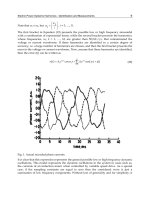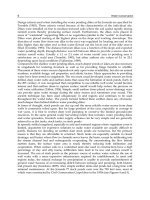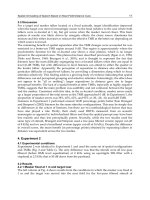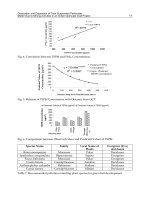Polyme Analysis 2010 Part 2 docx
Bạn đang xem bản rút gọn của tài liệu. Xem và tải ngay bản đầy đủ của tài liệu tại đây (425.16 KB, 9 trang )
What are our expectations of polymer materials?
•Excellent Characteristics:
Mechanical and Physical Properties
Thermal Behaviour
Surface and interface Characteristics
Electrical and Optical Properties
•Safe to use
•Light weight
•Reliable, durable
•Low cost
•Less adverse environmental impact
•Good resistance to environmental attacksMechanical Testing
of Polymers
Types of MechnicalTests
Tensile test (a)
Flexural test (d) (e) (f)
Compression test (b) Shear (g)
(h)
(i)
Impact test (h) (i)
Scope:
üMeasure the force required to break a specimen and the extent to which the
specimen stretches or elongates to that breaking point.
üProduce a stress-strain diagram, which is used to determine tensile modulus.
üThe data is often used to specify a material, to design parts towithstand
application force and as a quality control check of materials.
üSince the physical properties of many materials (especially thermoplastics) can
vary depending on ambient temperature ⇒ test materials at temperatures that
simulate the intended end use environment.
Tensile test
Specimen Size:
üThe most common specimen for ISO 527 is the ISO 3167 Type 1A
multipurpose specimen.
üASTM D882 uses strips cut from thin sheet or film.
*The multipurpose test specimen:
+150 mm long,
+The centersection: 10 mm wide *4 mm thick *80 mm long.
Tensile test
A tensile dog bone specimen
b
W
l
δ
For the composite samples
Longitudinal test
Transverse test
Test Procedure:
üSpecimens are placed in the
grips and pulled until failure.
üFor ASTM D638, the test
speed is determined by the
material specification.
üFor ISO 527 the test speed
is typically 5 or 50mm/min for
measuring strength and
elongation
+and 1mm/min for measuring
modulus.
ü An extensometer is used to
determine elongation and
tensile modulus.
Tensile test
Tensile2.wmv









